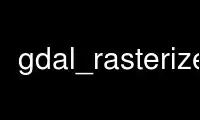
This is the command gdal_rasterize that can be run in the OnWorks free hosting provider using one of our multiple free online workstations such as Ubuntu Online, Fedora Online, Windows online emulator or MAC OS online emulator
PROGRAM:
NAME
gdal_rasterize - gdal_rasterize burns vector geometries into a raster
SYNOPSIS
Usage: gdal_rasterize [-b band]* [-i] [-at]
[-burn value]* | [-a attribute_name] [-3d]
[-l layername]* [-where expression] [-sql select_statement]
[-of format] [-a_srs srs_def] [-co "NAME=VALUE"]*
[-a_nodata value] [-init value]*
[-te xmin ymin xmax ymax] [-tr xres yres] [-tap] [-ts width height]
[-ot {Byte/Int16/UInt16/UInt32/Int32/Float32/Float64/
CInt16/CInt32/CFloat32/CFloat64}] [-q]
<src_datasource> <dst_filename>
DESCRIPTION
This program burns vector geometries (points, lines and polygons) into the raster band(s)
of a raster image. Vectors are read from OGR supported vector formats.
Note that the vector data must in the same coordinate system as the raster data; on the
fly reprojection is not provided.
Since GDAL 1.8.0, the target GDAL file can be created by gdal_rasterize. One of -tr or -ts
option must be used in that case.
-b band:
The band(s) to burn values into. Multiple -b arguments may be used to burn into a list
of bands. The default is to burn into band 1.
-i:
Invert rasterization. Burn the fixed burn value, or the burn value associated with the
first feature into all parts of the image not inside the provided a polygon.
-at:
Enables the ALL_TOUCHED rasterization option so that all pixels touched by lines or
polygons will be updated not just those one the line render path, or whose center
point is within the polygon. Defaults to disabled for normal rendering rules.
-burn value:
A fixed value to burn into a band for all objects. A list of -burn options can be
supplied, one per band being written to.
-a attribute_name:
Identifies an attribute field on the features to be used for a burn in value. The
value will be burned into all output bands.
-3d:
Indicates that a burn value should be extracted from the 'Z' values of the feature.
These values are adjusted by the burn value given by '-burn value' or '-a
attribute_name' if provided. As of now, only points and lines are drawn in 3D.
-l layername:
Indicates the layer(s) from the datasource that will be used for input features. May
be specified multiple times, but at least one layer name or a -sql option must be
specified.
-where expression:
An optional SQL WHERE style query expression to be applied to select features to burn
in from the input layer(s).
-sql select_statement:
An SQL statement to be evaluated against the datasource to produce a virtual layer of
features to be burned in.
-of format:
(GDAL >= 1.8.0) Select the output format. The default is GeoTIFF (GTiff). Use the
short format name.
-a_nodata value:
(GDAL >= 1.8.0) Assign a specified nodata value to output bands.
-init value:
(GDAL >= 1.8.0) Pre-initialize the output image bands with these values. However, it
is not marked as the nodata value in the output file. If only one value is given, the
same value is used in all the bands.
-a_srs srs_def:
(GDAL >= 1.8.0) Override the projection for the output file. If not specified, the
projection of the input vector file will be used if available. If incompatible
projections between input and output files, no attempt will be made to reproject
features. The srs_def may be any of the usual GDAL/OGR forms, complete WKT, PROJ.4,
EPSG:n or a file containing the WKT.
-co 'NAME=VALUE':
(GDAL >= 1.8.0) Passes a creation option to the output format driver. Multiple -co
options may be listed. See format specific documentation for legal creation options
for each format.
-te xmin ymin xmax ymax :
(GDAL >= 1.8.0) set georeferenced extents. The values must be expressed in
georeferenced units. If not specified, the extent of the output file will be the
extent of the vector layers.
-tr xres yres :
(GDAL >= 1.8.0) set target resolution. The values must be expressed in georeferenced
units. Both must be positive values.
-tap:
(GDAL >= 1.8.0) (target aligned pixels) align the coordinates of the extent of the
output file to the values of the -tr, such that the aligned extent includes the
minimum extent.
-ts width height:
(GDAL >= 1.8.0) set output file size in pixels and lines. Note that -ts cannot be used
with -tr
-ot type:
(GDAL >= 1.8.0) For the output bands to be of the indicated data type. Defaults to
Float64
-q:
(GDAL >= 1.8.0) Suppress progress monitor and other non-error output.
src_datasource:
Any OGR supported readable datasource.
dst_filename:
The GDAL supported output file. Must support update mode access. Before GDAL 1.8.0,
gdal_rasterize could not create new output files.
EXAMPLE
The following would burn all polygons from mask.shp into the RGB TIFF file work.tif with
the color red (RGB = 255,0,0).
gdal_rasterize -b 1 -b 2 -b 3 -burn 255 -burn 0 -burn 0 -l mask mask.shp work.tif
The following would burn all 'class A' buildings into the output elevation file, pulling
the top elevation from the ROOF_H attribute.
gdal_rasterize -a ROOF_H -where 'class="A"' -l footprints footprints.shp city_dem.tif
AUTHORS
Frank Warmerdam [email protected]
Use gdal_rasterize online using onworks.net services
